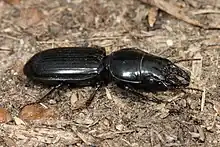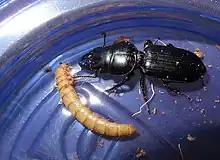Scarites subterraneus
Scarites subterraneus, known generally as the big-headed ground beetle or (tunneling large) pedunculate ground beetle, is a species of ground beetle in the family Carabidae. It is found throughout the Caribbean, Central America, and North America.[1][2][3][4]
| Scarites subterraneus | |
|---|---|
 | |
| Scientific classification | |
| Domain: | Eukaryota |
| Kingdom: | Animalia |
| Phylum: | Arthropoda |
| Class: | Insecta |
| Order: | Coleoptera |
| Family: | Carabidae |
| Genus: | Scarites |
| Species: | S. subterraneus |
| Binomial name | |
| Scarites subterraneus Fabricius, 1775 | |

Description
These beetles are generally between 15.0-30.0 mm.[5] They have large mandibles, which have two teeth, for hunting and consuming their prey. The antenna of the creature are not clubbed or elbowed, rather, segmented. The elytra of S. subterraneus is fairly striated (streaked). Their front femora are adapted to dig.[6][7] Wings present. Forebody loosely attached to the body. Antennomeres are 8-10 moniliform.[5]
Habitat
Scarites subterraneus, as its scientific name suggests, spends much of its time burrowing and hiding under logs, rocks, soil and leaf litter. [8] They are found in a variety of habitats, such as forests and meadows. They are frequently encountered in residential areas, urban and rural alike.[9] Their environment is generally defined as coastal.[10]
Diet
Scarites subterraneus is a carnivorous beetle. This is clear when looking at its large jaws, which it uses to hunt its prey.[11] The specific diet of S. subterraneus is not remarkably clear (they seem to be willing to eat any invertebrate in any stage of life), but in captivity they have been observed to happily eat mealworms.
Habits
Scarites subterraneus spends the day hiding under safe places (such as the aforementioned logs, rocks, and leaf litter) and comes out at night in search of prey.[7] When startled, the beetles stiffen up, tuck in their limbs, and play dead.[12] This habit is kept up until they feel safe to return to their "living" mode. Usually, this is when they are in a place they can easily escape from a predator in, or when the predator is out of sight. Adults are generally the most active during spring and summer. They are quite fond of light, and can be found at porch lights often.[5]
Predators
Predators of Scarites subterraneus are not very well studied, but American Robins, Eastern Bluebirds, Hermit Thrush, and Northern Cardinals have been observed consuming them.[13]
References
- "Scarites subterraneus Report". Integrated Taxonomic Information System. Retrieved 2019-09-23.
- "Scarites subterraneus". GBIF. Retrieved 2019-09-23.
- "Scarites subterraneus species Information". BugGuide.net. Retrieved 2019-09-23.
- Bousquet, Yves (2012). "Catalogue of Geadephaga (Coleoptera, Adephaga) of America, north of Mexico". ZooKeys (245): 1–1722. doi:10.3897/zookeys.245.3416. PMC 3577090. PMID 23431087.
- V. Evans, Arthur (2014). Beetles of Eastern North America. Princeton University Press. p. 75. ISBN 978 0 691 13304 1.
- "Species Scarites subterraneus - Big-headed Ground Beetle". bugguide.net. Retrieved 2023-04-25.
- "Burrowing Big-headed Ground Beetle". Project Noah. Retrieved 2023-04-25.
- "Species Scarites subterraneus - Big-headed Ground Beetle". bugguide.net. Retrieved 2023-04-25.
- "Burrowing Big-headed Ground Beetle". Project Noah. Retrieved 2023-04-25.
- "Big-headed Ground Beetle - Encyclopedia of Life". eol.org. Retrieved 2023-04-25.
- "Burrowing Big-headed Ground Beetle". Project Noah. Retrieved 2023-04-25.
- Ago, Sustainablyyoursin #nature • 6 Years (2017-08-25). "Daily Photo Shoot (8/25/17): Big Headed Ground Beetle (Scarites subterraneous)". Steemit. Retrieved 2023-04-25.
- "Big-headed Ground Beetle - Encyclopedia of Life". eol.org. Retrieved 2023-04-25.
Further reading
- Lobl, I.; Smetana, A., eds. (2017). Catalogue of Palaearctic Coleoptera, Volume 1: Archostemata - Myxophaga - Adephaga. Apollo Books. ISBN 978-90-04-33029-0.
External links
 Media related to Scarites subterraneus at Wikimedia Commons
Media related to Scarites subterraneus at Wikimedia Commons